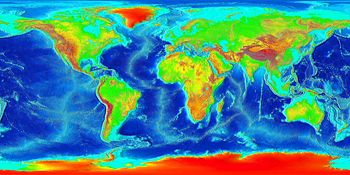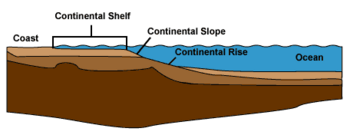The continental shelf is the extended perimeter of each continent that is covered by relatively shallow seas and gulfs during interglacial periods (such as the current epoch). A sea that lies over a continental shelf is called a shelf sea. Most of the sediment on continental shelves was deposited during the last ice age.
Continental shelves are commercially exploited for the ores and fossil fuels that can be extracted from them, and the waters above the shelves provide a wealth of seafood.
Topography
The width of the continental shelf varies considerably, with some areas having virtually no shelf at all. The average width of continental shelves is about 80 kilometers (km) (50 miles (mi)). The depth of the shelf also varies, but it is generally limited to water that is shallower than 150 meters (m) (490 feet (ft)).[1] The slope of the shelf is usually quite low, on the order of 0.5 degrees. Its vertical relief is also minimal, at less than 20 m (65 ft).[2]
The continental shelf usually ends with an edge where the slope increases sharply, called the shelf break. The sea floor below the break is called the continental slope, which is also regarded as part of the continent. The continental slope forms a connection between the continental shelf and the oceanic crust.[3]
Below the continental slope is the continental rise, another sloping area that eventually merges into the deep ocean floor, the abyssal plain. The continental shelf and slope are part of the continental margin.
The shelf area is commonly subdivided into the inner continental shelf, mid-continental shelf, and outer continental shelf. Each of these parts has its specific geomorphology and marine biology.
The character of the shelf changes dramatically at the shelf break, where the continental slope begins. With a few exceptions, the shelf break is located at a remarkably uniform depth of roughly 140 meters (m) (460 feet (ft)). This feature is likely a hallmark of past ice ages, when sea level was lower than what it currently is.[4]
The continental slope is much steeper than the shelf; the average angle is three degrees, but it can be as low as one degree or as high as ten degrees.[5] The slope is often cut by submarine canyons, features whose origin was mysterious for many years.[6]
The continental rise is below the slope, but landward of the abyssal plain. Its gradient is intermediate between the slope and the shelf, on the order of 0.5-1 degrees.[1] Extending as far as 500 km from the slope, it consists of thick sediments deposited by turbidity currents from the continental shelf and slope. Sediment cascades down the slope and accumulates as a pile of sediment at the base of the slope, called the continental rise.[7]
Although the continental shelf is treated as a physiographic province of the ocean, it is not part of the deep ocean basin proper but corresponds to the flooded margins of the continent.[8] Passive continental margins, such as most of the Atlantic coasts, have wide and shallow shelves, made of thick sedimentary wedges derived from long erosion of a neighboring continent. Active continental margins have narrow, relatively steep shelves, due to frequent earthquakes that move sediment to the deep sea.[9]
Examples
Some coastlines are almost devoid of a continental shelf, particularly in places where the forward edge of an advancing oceanic plate dives beneath the continental crust in an offshore subduction zone. Examples of this feature have been found off the coast of Chile and the west coast of Sumatra. By contrast, the Siberian Shelf in the Arctic Ocean is the largest shelf, stretching to a width of 1500 km (930 mi). The South China Sea lies over another extensive area of continental shelf, the Sunda Shelf, which joins Borneo, Sumatra, and Java to the Asian mainland. Other familiar bodies of water that overlie continental shelves are the North Sea and Persian Gulf.
Sediments
Continental shelves are covered by terrigenous sediments, that is, sediments derived from erosion of the continents. However, only a minor portion of the sediments can be traced to material carried by present-day rivers. About 60-70 percent of the sediment on the world's continental shelves is relict sediment, deposited during the last ice age, when the sea level was 100-120 meters lower than it currently is.[10]
Sediments usually become increasingly fine with distance from the coast. Sand is limited to shallow, wave-agitated waters, while silt and clays are deposited in quieter, deep water, far offshore.[11] These shelf sediments accumulate at an average rate of 30 centimeters (cm) per 1,000 years, with a range from 15-40 cm.[12] Though slow by human standards, this rate is much faster than that for deep-sea pelagic sediments.
Teeming with life
Given that sunlight is available in shallow waters, continental shelves teem with life. By comparison, the abyssal plains of the oceans are biotic deserts. The pelagic (water column) environment of the continental shelf constitutes the neritic zone, and the benthic (sea floor) province of the shelf is the sublittoral zone.[13]
The shelves are usually fertile, but if anoxic conditions in the sedimentary deposits prevail, the shelves may, over geologic time, become sources of fossil fuels.
Economic significance and sovereignty
The relatively accessible continental shelf is the best understood part of the ocean floor. Most of the commercial exploitation of the sea—such as the extraction of metallic ore, nonmetallic ore, and fossil fuels (oil and natural gas)—takes place in the region of the continental shelf. In addition, the waters above the shelf constitute a rich source of seafood.
Given this background, nations with open coastlines have claimed sovereign rights over their continental shelves up to 350 nautical miles from the coast. To institute their claims, various marine nations signed the Convention on the Continental Shelf drawn up by the U.N. International Law Commission in 1958, which was partly superseded by the 1982 United Nations Convention on the Law of the Sea.[14]
Terminology
- Abyssal plain: It is a flat or very gently sloping area of the deep ocean floor. Abyssal plains are among the Earth's flattest and smoothest regions and the least explored. They cover approximately 40 percent of the ocean floor and reach depths between 2,200 and 5,500 m (7,200 and 18,000 ft). They generally lie between the foot of a continental rise and a mid-oceanic ridge.
- Continental margin: The continental shelf and continental slope together make up the continental margin.[15] The transition from continental crust to oceanic crust commonly occurs within the outer part of the margin, called the continental rise.
See also
- Land bridge
- Ocean
- Oceanography
- Territorial waters
Notes
- ↑ 1.0 1.1 Pinet 1996, p. 37.
- ↑ Pinet 1996, pp. 36-37.
- ↑ Ocean Regions: Ocean Floor - Continental Margin & Rise Office of Naval Research. Retrieved June 18, 2008.
- ↑ Gross 1972, p. 43.
- ↑ Pinet 1996, p. 36; Gross 1972, p. 43.
- ↑ Pinet 1996, p. 98; Gross 1972, p. 44.
- ↑ Pinet 1996, p. 39; Gross 1972, p. 45.
- ↑ Pinet 1996, pp. 35-36.
- ↑ Pinet 1996, pp. 90-93.
- ↑ Pinet 1996, pp. 84-86; Gross, 1972, p. 43.
- ↑ Gross 1972, pp. 121-22.
- ↑ Gross 1972, p. 127.
- ↑ Pinet 1996, pp. 316-17, 418-19.
- ↑ U.N. Convention on the Continental Shelf, 1958 Retrieved June 18, 2008.
- ↑ Ocean Regions: Ocean Floor - Continental Margin & Rise Office of Naval Research. Retrieved June 18, 2008.
ReferencesISBN links support NWE through referral fees
- Cook, Peter J., and Chris M. Carleton (eds.). Continental Shelf Limits: The Scientific and Legal Interface. Oxford, UK: Oxford University Press, 2000. ISBN 0195117824
- Garrison, Tom S. Oceanography: An Invitation to Marine Science. Boston, MA: Brooks Cole, 2007. ISBN 049511913X
- Gross, Grant M. Oceanography: A View of the Earth. Englewood Cliffs, NJ: Prentice-Hall, 1972. ISBN 0136296599
- Nordquist, Myron H., John Norton Moore, and Tomas H. Heidar. Legal and Scientific Aspects of Continental Shelf Limits. Center for Oceans Law and Policy, University of Virginia. Leiden: M. Nijhoff, 2004. ISBN 978-9004139121
- Pinet, Paul R. Invitation to Oceanography, 3rd ed. St. Paul, MN: West Publishing Co., 1996. ISBN 0763721360
External links
All links retrieved January 7, 2024.
- What is a Continental Shelf? wisegeek.com.
- UNEP Shelf Programme UNEP/GRID-Arendal.
- Commission on the Limits of the Continental Shelf (CLCS) United Nations, Oceans and Law of the Sea.
Credits
New World Encyclopedia writers and editors rewrote and completed the Wikipedia article in accordance with New World Encyclopedia standards. This article abides by terms of the Creative Commons CC-by-sa 3.0 License (CC-by-sa), which may be used and disseminated with proper attribution. Credit is due under the terms of this license that can reference both the New World Encyclopedia contributors and the selfless volunteer contributors of the Wikimedia Foundation. To cite this article click here for a list of acceptable citing formats.The history of earlier contributions by wikipedians is accessible to researchers here:
The history of this article since it was imported to New World Encyclopedia:
Note: Some restrictions may apply to use of individual images which are separately licensed.

